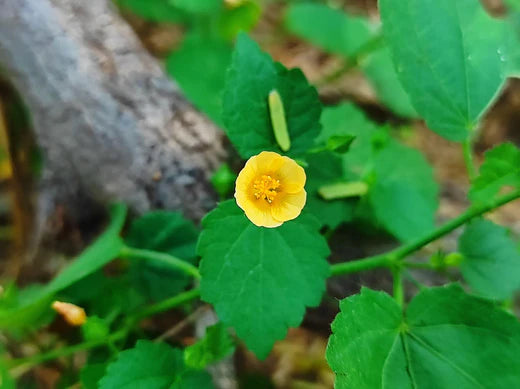Sida cordifolia is the scientific name for Bala. Sida cordifolia is a perennial herb that can reach a height of 30 meters. Bala leaves have 6-7 veins, are oblong or oval, and measure 2.5-7 cm in length by 2.5-5 cm wide. Bala leaves are truncate, heart-shaped, and serrated. The plant produces tiny, axillary, single, white, or yellow blooms. Bala has thick, sturdy stems and roots. Bala roots have an unpleasant flavor, have no smell, and have a grayish-yellow appearance. Most tap roots have branches at the apex. Moong-sized, disc-shaped, and velvety in the upper half, Bala fruits are 6 to 8 mm in diameter. Bala Seeds, also known as bajibanda in Ayurveda, are smooth and seem grayish-black in color. Plants bloom from August to December, and their fruits ripen from October to January.
General Description
Sida cordifolia is also known by the popular names Bala and rural mallow. The Bala plant is used in the Ayurveda medical system to create medications. It is used in Ayurveda to calm all three of the bodily energies—vata, pitta, and kapha—but is particularly successful for the vata dosha. Bala is utilized to raise the shukra dhatu and is well known for its shukrala qualities. It is used to increase sperm count while also improving sperm quality. This herb is utilized in Ayurveda as a hypotensive, CNS depressive, analgesic, anti-inflammatory, and hypoglycemic drug. For a variety of vata problems, rasayana, and nervine tonics are best; they promote ayurveda for pitta imbalance. The greatest treatment for piles and raktapitta is bala, which is a blood purifier. Moreover, it promotes fetal growth. Bleeding piles can be treated with cooked leaves.
Ephedrine, sterculic acid, malvalic and coronaric acid, pseudoephedrine, fatty acids, saponine, hypaphorine, ecdysterone, indole alkaloids, palmitic acid, stearic acid, and ole-beta-sitosterol are the main chemical components found in this plant. Both ephedrine and pseudoephedrine, which are chemical substances used to activate the central nervous system, are present in Sida.
Bala Classification
- Kingdom - Plantae
- Order - Malvales
- Family - Malvaceae
Bala Habitat
Sida cordifolia, sometimes called Bala, is a common plant that grows along roadsides and wastelands and is indigenous to India. All of India and Sri Lanka's tropical and subtropical regions include Bala. In Africa, Australia, Hawaii, the Southern United States, and New Guinea, it is regarded as an invasive weed.
Bala Other Names
- Latin name - Sida cordifolia
- Common name - Country mallow, Heart-leaf sida
- Sanskrit name - Badiyalaka, Bala, Baladaya
- Bengali name - Berela
- Assamese name - Bor sonborial
- Hindi name - Kharinta, Barial
- Kannada name - Chittuharalu, Hettuti-gida
- Malayalam name - Katturam
- Tamil name - Chittamuttie
- Telugu name - Chirubenda, Mailmanikkam
- Marathi name - Bala, Chikana, Tupkaria
- Oriya name - Bajromuli, Bisiripi
- Marathi name - Chikana, Karaiti
- Gujarati name - Jangli methi
- Chinese name - Yuan ye jin wu shi hua, Xin ye huang hua ren, Ke dong
- French name - Herbe de douze heyres
- Japanese name - Maruba kingojika
- Nepalese name - Balu
- Russian name - Sida Kordifolia, Sida Serdtselistania
- Spanish name - Escoba Negra, Escobilla, Llima
- Thai name - Ya khat bai pom
Ayurvedic Properties
|
|
Hindi / Sanskrit |
English |
|
Rasa (Taste) |
Madhura |
Sweet |
|
Guna (Physical Property) |
Laghu, Snigdha, Pichila |
Light, Unctuousness, Sticky |
|
Virya (Potency) |
Sheeta |
Cold |
|
Vipaka (Post-Digestive Taste) |
Madhura |
Sweet |
Effects on Doshas
It balances all three doshas (Vata, Pitta & Kapha).
|
Charak Samhita |
Sushrut Samhita |
|
|
Practical Uses
- Bala is used to lessen inflammation in wounds and eyes since it has anti-inflammatory properties. Its external application is indicated to lessen joint stiffness and arthritis discomfort. Its external paste is applied to treat wounds and ocular conditions.
- Patients who have paralysis, facial paralysis, or cervical spondylitis benefit greatly from the oil made from this herb.
- Assists in the gut's absorption of both water and nutrients, and it is highly effective at regulating intestine motility. These characteristics make this plant highly useful in treating grahani, or irritable bowel syndrome.
- It is utilized as a heart tonic and to lessen petechial bleeding.
- Male and female infertility are both treated with bala. It is used to improve sperm motility and sperm count in males. This herb is known as vrishya, or aphrodisiac, in Ayurveda. Male erectile dysfunction and early ejaculation are both treated with it.
- It revitalizes the urinary system, acts as a diuretic, and aids in the treatment of cystitis.
- The bala plant helps with bronchitis, asthma, and stomatitis as well as relieving chest congestion.
- Sida cordifolia root infusion is highly beneficial for problems of the neurological and urogenital systems. Disorders of the bile and blood can also be treated with it.
- Vata, pitta, and kapha are the three doshas that it is used to calm; they support and are useful ayurveda for Kapha balance.
Part used
- Bala Roots
- Bala Bark
- Bala Leaves
- Bala Flowers
- Bala Seeds
Dosage
- Powder - 3-6gms
- Juice extract - 10-20ml
- Decoction - 50-100ml
Cautions
Sida cordifolia contains ephedrine, and using it excessively results in
- Insomnia
- Anxiety
- Nervousness
- Rise in blood pressure
- Memory loss
- Stroke
Ayurveda Products that Use Bala
Bala Ashwagandha Oil
Dashmool Bala Oil

